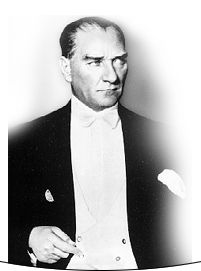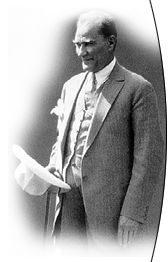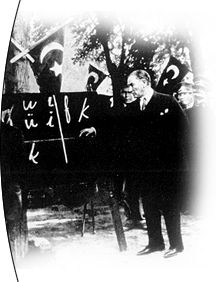ATATURK, FOUNDER OF THE TURKISH REPUBLIC AND THE FIRST PRESIDENT OF THE REPUBLIC
Mustafa Kemal Atatürk (1881-1938)

ATATURK, FOUNDER OF THE TURKISH REPUBLIC AND THE FIRST PRESIDENT OF THE REPUBLIC
Mustafa
Kemal Atatürk was born in a three-storey pink house at Islahhane
Street, Kocakasim District, Salonika in 1881. His father was Ali Riza
Efendi and mother was Zübeyde Hanim. His paternal grand father Hafiz
Efendi is a member of Kocacik Nomads from Konya and Aydin region, which
was settled in Macedonia during the 14th-15th centuries. His mother Zübeyde
Hanim, also a daughter of an old Turkish family, settled in the town of
Langasa near to Salonika. Ali Riza Efendi who worked in various areas such
as; a military officer, a pious foundation clerk and for some time a
timber merchant and got married with Zübeyde Hanim in 1871. Four of
Atatürk's five siblings died at an early age, only his sister Makbule
Atadan survived and lived until 1956.
 Atatürk's Address to the Youth of Türkiye (1.71 MB)
Atatürk's Address to the Youth of Türkiye (1.71 MB)
Young Mustafa commenced his education in the Hafiz Mehmet Efendi's neighborhood
school, later he was transferred to the Semsi Efendi School, because his
father wished so (Comparatively a more modern education at the time.) During
his primary education, he lost his father in 1888. For a while he stayed in his uncle's farm in Rapla, then returned to Salonika and completed his
primary education. He enrolled into the Salonika Junior High School for Civil
Servants. After a short time in 1893, he transferred to the Military Junior
High School. It is at this school that his math teacher Mustafa Bey, added
Kemal to his name between 1896-1899, Mustafa Kemal finished the Monastir
Military Senior High School and commenced the Military College in Istanbul.
In 1902 he graduated with the rank of lieutenant and continued his
education in the Military Academy. In January 1905 he completed the Academy
and graduated with the rank of a captain. His first appointment was in 5
Army in Damascus between 1905-1907. He was promoted to adjutant
major in 1907 and appointed to 3 Army in Monastery. He was the Chief of
Staff of the Army Corps which entered Istanbul on the 19th of April 1909. He was
sent to France in 1910 and took part in the Picardie Manoeuvres. In 1911 he
was back in Istanbul and started to work under the Command of General
Staff. 
Mustafa
Kemal and a group of friends took part in the Tobruk and Derna Fronts
during the war which started in 1911 against Italians who were
attacking Tripoli (Libya). He won the Battle of Tobruk against the
Italian forces on the 22nd of December 1911. He was then appointed to the Derna Front
as the Commander-in-Chief on the 6th of March 1912.
When the Balkan War
started in October 1912, Mustafa Kemal joined the battle with units in
Gelibolu (Gallipoli) and Bolayir. He greatly contributed to the
retrieval of Edirne and Dimetoka (Dhidhimotikhon). In 1913 he was
appointed to Sofia as the military attache. During his assignment in
Sofia he was promoted to the lieutenant-colonel grade. His duty as the military
attache ended in January 1915. During his stay in Sofia, the First World
War had started and the Ottoman Empire had become obliged to enter
this war. Mustafa Kemal was appointed to Tekirdag to organize the 19
Division.
It is in the First World War, which started in 1914, that
Mustafa Kemal wrote an heroic epic and made the legend of 'Dardanelles
are Impassable' against Entente troops in Gallipoli. On the 18th of March 1915,
when British and French navies failed to break in through the Straits of
Dardanelles with heavy losses, the decision to land troops on the
Gallipoli peninsula had been given. Under the command of Mustafa Kemal,
19 Division halted the enemy forces, which landed in Ariburnu -now
called Anzak Koyu (Anzac Cove)- on the 25th of April 1915 at Conkbayir. Mustafa
Kemal was promoted to full colonel after this great success. British
forces started attacking again from Ariburnu on the 6th and 7th of August 1915.
Anafartalar Group Commander Mustafa Kemal won the victory of Battle of
Anafartalar on 9-10 August. Following this, he also won the victories of
Battle of Kirectepe on the 17th of August and the Second Battle of Anafartalar on the 21st of
August. The Turkish nation defended its honor in Gallipoli (Battle of
Canakkale) against the Entente States by losing approximately 253,000 of its sons to martyrdom. Mustafa Kemal's famous order to his soldiers "I do
not order you to attack, I order you to die", had changed the destiny of
this Front.
 In
1916 after Gallipoli, Mustafa Kemal took duties in Edirne and in
Diyarbakir. He was promoted to brigadier general on the 1st of April 1916. He
took part in the battles against the Russian forces by which Mus and Bitlis
were liberated. After short duties in Damascus and Aleppo, he returned
to Istanbul in 1917. He went to Germany with the Heir Apparent Prince
Vahdeddin Efendi for observations in the European Western Front. He
became sick after this trip and received treatment in Vienna and
Carlsbad. He returned to the Front on the 15th of August 1918 as the
Commander-in-Chief of the 7 Army in Aleppo. At this front he achieved
the most successful defensive battles in history against the British
forces. He was appointed as the Commander-in-Chief of the Lightning Army
Group on the 31st of October 1918, just one day after the signing of the truce
in Moudros. After the abolition of this Army Group he was appointed
for a duty in the Ministry of War in Istanbul on the 13th of November 1918.
In
1916 after Gallipoli, Mustafa Kemal took duties in Edirne and in
Diyarbakir. He was promoted to brigadier general on the 1st of April 1916. He
took part in the battles against the Russian forces by which Mus and Bitlis
were liberated. After short duties in Damascus and Aleppo, he returned
to Istanbul in 1917. He went to Germany with the Heir Apparent Prince
Vahdeddin Efendi for observations in the European Western Front. He
became sick after this trip and received treatment in Vienna and
Carlsbad. He returned to the Front on the 15th of August 1918 as the
Commander-in-Chief of the 7 Army in Aleppo. At this front he achieved
the most successful defensive battles in history against the British
forces. He was appointed as the Commander-in-Chief of the Lightning Army
Group on the 31st of October 1918, just one day after the signing of the truce
in Moudros. After the abolition of this Army Group he was appointed
for a duty in the Ministry of War in Istanbul on the 13th of November 1918.
After
the beginning of the occupation of the country and the demobilization of
the Ottoman armies according to the Moudros Truce, Mustafa Kemal arrived
in Samsun on the 19th of May 1919 as the Inspector General of the 9 Army. On the 22nd of
June 1919, he issued the Amasya Circular, declaring that the nation's
determination and decision will restore the nation's independence and
called for the gathering of Congress in Erzurum and Sivas. Between 23
July and 7 August 1919 delegates from all over the country gathered in
Erzurum and then between the 4th of September and the 11th of September 1919 in Sivas,
determining the path to follow in order to gain the nation’s independence.
On the 27th of December 1919 he was welcomed in Ankara with great enthusiasm. The 23rd of
April 1920, in the first day of the Turkish Grand National Assembly, was
one of the very important steps on the way to the founding of the
Turkish Republic. Mustafa Kemal was elected as the first Speaker of the
House and the Head of the Government. The Turkish Grand National
Assembly started preparing and passing the new laws necessary for
implementing the Independence War successfully.
The Turkish
Independence War started when the first bullet was fired against the
enemy during the occupation of Izmir by the Greek forces on the 15th of May
1919. Victors of the First World War, by signing the Sevres
Agreement, started the occupation of their shares of the Ottoman Empire.
At the beginning, resistance against occupation forces started with
militia forces, namely Kuva-i Milliye (National Forces). The Turkish
Grand National Assembly established the regular army and successfully
led the Independence War to victory by integrating the militia forces
into the regular army.
The important stages of the Independence War under the leadership of Mustafa Kemal were the :
• Liberation of Sarikamis (20th of September 1920), Kars (30th of October 1920) and Gümrü (7th of November 1920).
• Defences of Cukurova, Gaziantep, Sanliurfa and Kahraman Maras (1919-1920).
• Victory at the First Battle of Inönü (6th-10th of January 1920)
• Victory at the Second Battle of Inönü (23rd of March-1th of April 1920).
• Victory at the Battle of Sakarya (23rd of August-13 September 1921).
•
Great Offensive, Battle of Dumlupinar (Battle of Commander-in-Chief)
and the Great (Final) Victory (26 August-9 September 1922).
After
the victory at the Battle of Sakarya, the Turkish Grand National
Assembly promoted Mustafa Kemal to the rank of Field Marshal and granted
him the title of Gazi-the Victorious Fighter. The Independence War ended by the Lausanne Peace Treaty on the 24th of July 1923. Thus, all the
impediments of the Sevres Agreement had been removed and the integrity of
the Turkish land had been accomplished by the signing of the Lausanne
Agreement. There were no obstructions left on the way to establish the
new Turkish State based on the national solidarity.
Founding of the
Turkish Republic had been heralded by the opening of the Turkish Grand
National Assembly on the 23rd of April 1920. National Assembly's successful
administration during the Independence War had secured the founding of
the new Turkish State. Caliphate and Sultanate (monarchy) separated and
Sultanate was abolished on the 1rd of November 1922. Therefore, the
administrative ties with the Ottoman Empire were broken. The declaration
of the Republic was made on 29th of October 1923 and Mustafa Kemal was
unanimously elected as the first President of the Republic. Ismet Inönü
formed the first government of the Republic on the 30th of October 1923.
Sovereignty unconditionally belongs to the Nation and Peace at home, peace
in the world are the raising fundamentals of the Turkish Republic.
Atatürk
made many reforms in order to bring Türkiye to the level of contemporary
civilizations. Those reforms can be put under five main topics:
1. Political Reforms 
- Abolition of the Sultanate (1st of November 1922)
- Declaration of the Republic (29th of October 1923)
- Abolition of Caliphate (3rd of March 1924)
2. Social Reforms
- Women were given equal rights with men (1926-1934)
- The Revolution of Headgear and Outfit (25th of November 1925)
- Closing of dervish lodges and shrines (30th of November 1925)
- The surname law (21st of June 1934)
- Abolition of nicknames, pious and royal titles (26th of November 1934)
- Adoption of the International calendar, time and measurements (1925-1931)
3. Juridical Reforms
- Abolition of the Canon Law (1924-1937)
- Instating the new Turkish Civil Code and other legislation to suit the secular order (1924 - 1937)
4. Educational and Cultural Reforms
- Integration of education (3rd of March 1924)
- Adoption of the new Turkish alphabet (1st of November 1928)
- Establishment of the Turkish Language and Historical Societies (1931-1932)
- Organization of the university education (31st May 1933).
- Innovations in fine arts
5. Economical Reforms
- Abolition of old taxation laws.
- Encouragement of the farmers.
- Establishment of model farms.
- Legislation of the Encouragement of the Industry Law and establishment of Industrial Corporations.
-
Implementing First and Second Development Plans (1933-1937),
construction of new highways to reach every corner of the country.
In
accordance with the new surname law, the Turkish Grand National Assembly
granted Mustafa Kemal with the surname Atatürk on the 24th of November 1934.
Atatürk
had been elected twice as the Speaker of the House (National Assembly),
on the 24th of April 1920 and the 13th of August 1923. His chairmanship at that time,
was equal to the Head of State and the Government combined. On the 29th of
October 1923, the Republic was declared and Atatürk was elected as the first
President of the Republic. According to the Constitution Presidential
elections held every four years. Atatürk had been re-elected as the
President of the Republic in 1927, 1931 and 1935 by the Turkish Grand
National Assembly.
Atatürk very frequently used to go for
fact-finding trips in the country. He kept in contact with local
authorities and directed them personally in every occasion. In the
capacity of the President of the Republic, he received the visiting
foreign presidents, premiers, ministers and commanders with great
respect and authority.
Atatürk gave his Great Speech on the 15th-20th of
October 1927 in which he described the Independence War and Founding of
Republic, he then made his 10th Year Speech on the 29th of October 1933.
Atatürk
was very modest in his private life. He married Latife Hanim on the 29th of
January 1923. Together they had many trips around the country. Their
marriage lasted until the 5th of August 1925. As a great children-lover,
Atatürk adopted his daughters Afet (Inan), Sabiha (Gökcen), Fikriye,
Ülkü, Nebile, Rukiye, Zehra and his son Mustafa, a young shepherd boy.
He also had two children under his protection, Abdurrahim and Ihsan. He
secured a good life and future for these children who survived.
In
1937, he donated his farms to the State Treasury and some of his real
estate to Ankara and Bursa Municipality Councils. He divided his
inheritance among his sister, his adopted children and the Turkish
Language and Historical Societies. He enjoyed reading, listening to music,
dancing, horse riding and swimming. He was very much interested in the
Western Anatolian folk dance Zeybek, wrestling and listening to Rumelia
songs. He had great pleasure in playing black-gammon and billiards. He
valued very much his horse Sakarya and his dog Fox. He had made up a
very rich library of his own. He used to invite statesmen, scholars and
scientists to dinners and discuss state affairs with them. He was very
particular about his appearance and was smartly dressed all the times.
He was also a nature lover. He very often used to visit his farm Atatürk
Orman Ciftligi-Atatürk Forest Farm and took part at works in person.
Atatürk was proficient in French and German.
On th 10th of November 1938
at 9.05 o'clock in the morning, in Istanbul, Dolmabahce Palace, he died of the
liver ailment he was suffering from. He was buried with a ceremonial
funeral in a temporary place of rest at the Ethnographical Museum in
Ankara on the 21st of November 1938. After the building of Anitkabir (Atatürk
Mausoleum) he was taken to his permanent place of rest with a grand
ceremony on the 10th of November 1953.
Culture is the foundation of the Turkish Republic.
Mustafa Kemal Atatürk, 1936
Atatürk's 10th Year Speech  nutuk.wav (4000 KB)
nutuk.wav (4000 KB)
 nutuk.rm (381 KB)
nutuk.rm (381 KB)